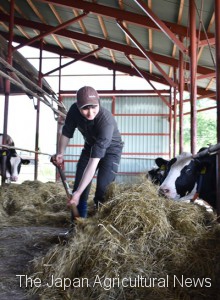
Hirohito Ono works inside a barn to keep his cows during the dry period located in Akkeshi, Hokkaido. Ono plans to rebuild the barn to improve the environment.
HOKKAIDO, June 29 – As the European Union strongly calls for liberalization of Japan’s dairy market such as cheese in the negotiations for the Japan-EU Economic Partnership Agreement, dairy farmers of Hokkaido are worried that the prices of raw milk would drop, turning their investments into debts.
Milk produced in Hokkaido occupies more than half of total production in Japan, and dairy farmers in the prefecture have fought to halt the decline in the nation’s milk production. However, 80 percent of milk produced in Hokkaido is used for processing, which means their produce will compete directly with products from the EU.
The farmers have made efforts to maintain and strengthen their production through expanding their business size and improving efficiency, but such investments could turn into debts if milk prices drop. Experts warn that if the dairy market is liberalized, producers of raw milk for processing use would face uncertainties securing buyers and the supply-demand balance of the nation’s raw milk market could be threatened.
“Hokkaido will be hardest hit” by the Japan-EU EPA because the region produces the largest amount of milk, says Hirohito Ono, 32, who takes care of 300 milk cows in the town of Akkeshi located in eastern Hokkaido, a major dairy production center in the prefecture.
This year, Ono built a new barn for newborn calves, which cost him a total of 20 million yen. He says the cost has risen due to an increase in prices of building materials. In the future, he hopes to boost income by building anew the main barn and a barn to keep cows during the dry period, as well as introducing milking robots to improve efficiency.
Ono says he is concerned over rising uncertainties, including soaring prices of heifers. “The government should give priority to measures to boost domestic production rather than to trade negotiations,” Ono said. “I don’t want the government to create more factors of concern.”
Dairy farmers are continuing to decrease even in Hokkaido. The number of dairy farms came to 6,490 in 2016, down some 2,000 from a decade ago. “Dairy farmers have recently become eager to continue production thanks to the rise in milk prices and the government’s dairy cluster program” aimed at improving profitability, says Nobuyuki Kawamura, head of JA Kushiro Ota, a local agricultural cooperative. “The government shouldn’t throw cold water on dairy farmers’ efforts.”
Domestic consumption of cheese, which has become the focus of Japan-EU negotiations, has expanded by 20 percent in the last decade and is expected to continue increasing. The government has taken policies to promote cheese consumption, such as supporting building of a factory by a major dairy products manufacturer and starting to subsidize producers of milk used to make cheese.
Encouraged by such income-boosting measures, the number of individual cheesemakers and small or medium-sized cheese manufacturers is also on the rise. The number of cheese producers excluding major dairy firms, which stood at around 150 nationwide in 2010, rose to 240 in 2014, mainly producing soft cheeses such as Mozzarella and Camembert.
In order to avoid causing an adverse effect on domestic manufacturers of soft cheese, negotiators of the Trans-Pacific Partnership trade talks agreed to abolish tariffs on hard cheeses. But EU negotiators have asked for further liberalization of the cheese market including soft cheeses. “We are worried that dairy farmers would become less willing to produce milk,” says an official of a major dairy products maker. “As cheese consumption is marking record-high levels, we hope the government will help maintain their willingness.”
Worries over the supply-demand balance of raw milk is also rising. “Japan-EU EPA could take away most of the demand for domestically-produced raw milk for cheese production,” warns Yoshiharu Shimizuike, lecturer at Hokkaido University’s Research Faculty of Agriculture who is well-versed in raw milk distribution, although noting that the fate of the market depends on how the TPP agreement, with 11 remaining members after the United States’ withdrawal, would turn out to be.

